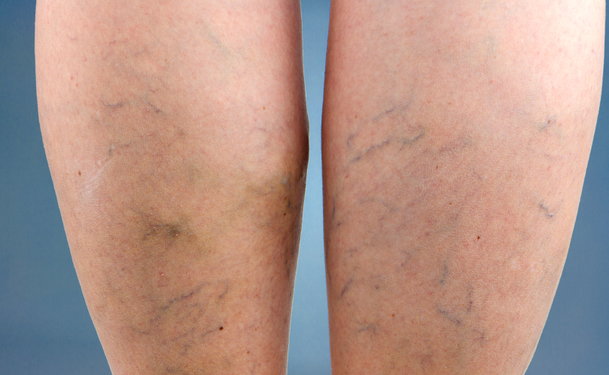Broken veins form when small veins just under the skin become swollen or dilated. They often occur on the legs but can show up on other parts of the body, such as the face. They are also known as telangiectasia or more commonly, spider veins.
Spider veins are not usually a health hazard but can cause burning or dull aches in the legs, especially after standing for long periods. They are a milder version of varicose veins, which can cause more severe symptoms and health problems.
Symptoms of Broken Veins
Spider veins show up as twisted or web-like patterns on the skin that are dark blue or purple. They can also cause burning, aching or pain in the affected area, especially after standing for a long time.
Varicose veins are a more severe form of spider veins and may affect deeper veins in the legs. These may appear swollen and raised. Spider veins are mainly a cosmetic concern. Varicose veins, though can sometimes lead to more serious health problems such as ulcers or venous inflammation (phlebitis).
Symptoms of varicose veins are also more severe than those of spider veins and include:
- Burning, throbbing, tingling, tiredness or heaviness in the legs
- Swollen legs
- Itching around the varicose vein
- Cramping of the muscles
- Aching or soreness in the legs
- Leg ulcers
- Discoloration of the skin, especially in the ankles
Symptoms of varicose veins and spider veins may worsen after sitting or standing for long periods. Women may also experience worsened symptoms during pregnancy.
Causes of Broken Veins
Varicose veins and spider veins develop when the walls and valves of the veins become weak. Instead of the blood moving toward the heart, it can pool inside the vein and cause it to enlarge.
Varicose veins and spider veins are more likely to occur when the pressure inside the leg is greater (such as during standing) or when the valves inside the vein are defective. The purpose of the valves is to keep blood from flowing backwards in the vein.
The risk factors for varicose veins and spider veins include:
- Family history of varicose veins or blood clots
- Advancing age
- Standing for long periods
- Being overweight
- Hormonal changes during pregnancy, birth control pill usage or post-menopausal hormonal replacement therapy
- Wearing tight-fitting clothes
- Vein injury
- Other health conditions that increase the pressure in the abdomen such as heart or liver disease, groin surgery or fluid in the abdomen
Treatments for Broken Veins
Spider veins are mainly a cosmetic problem. If you are concerned about the appearance of spider veins, several treatments are available, including:
- Sclerotherapy - During this treatment, your doctor injects a solution into the spider veins. This causes them to scar and close. The blood will then flow to other, healthier veins. The spider veins should fade within a few weeks. More than one treatment may be needed for a vein, although the procedure usually works the first time. The main side effects include itching, swelling or changes to the skin color in the area.
- Laser therapy - Your doctor aims strong bursts of laser light at the spider veins. This causes them to slowly fade and disappear. This procedure does not require any needles or incisions. Laser surgery works best for smaller veins. It can cause side effects such as itching, redness, swelling, bruising or permanent changes to the skin color.
It may take several months after treatment for spider veins to fade. In addition, they may not go away completely and can sometimes form again in the same area.
Varicose veins can also be treated with sclerotherapy and laser therapy, though laser therapy works best on spider veins and smaller varicose veins. Varicose veins can also be treated with:
- Endovenous thermal ablation therapy - A device is inserted into the vein through a small cut. Laser or radio waves are used to create heat that closes off the vein.
- Vein stripping - A long varicose vein is removed through several small incisions in the skin.
- Ambulatory phlebectomy - The varicose vein is removed one piece at a time through several small punctures in the skin.
- Endoscopic vein surgery - This procedure is used for more advanced types of varicose veins. A video camera is inserted into the leg. The vein is then closed and removed through small incisions in the skin.
Preventing Broken Veins
You may not be able to prevent varicose veins or spider veins from forming but some lifestyle changes may ease the symptoms or keep the varicose veins from getting worse. This includes:
- Exercising regularly
- Maintaining a healthy weight
- Not wearing tight-fitting clothes
- Elevating your legs frequently
- Avoiding standing or sitting for long periods
In addition, compression stockings may help with varicose veins before other treatments are needed. These squeeze the legs and help the veins and muscles move the blood toward the heart. The stockings can be found at most medical supply stores and pharmacies.


